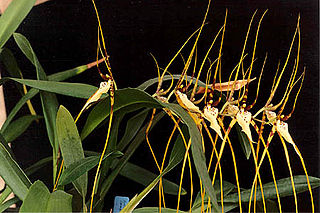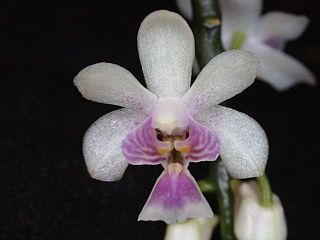
Paphiopedilum, often called the Venus slipper, is a genus of the lady slipper orchid subfamily Cypripedioideae of the flowering plant family Orchidaceae. The genus comprises some 80 accepted taxa including several natural hybrids. The genus is native to Southeast Asia, the Indian Subcontinent, southern China, New Guinea and the Solomon and Bismarck Islands. The type species of this genus is Paphiopedilum insigne.

Phragmipedium is a genus of the Orchid family (Orchidaceae) and the only genus comprised in the tribe Phragmipedieae and subtribe Phragmipediinae. The name of the genus is derived from the Greek phragma, which means "division", and pedium, which means "slipper". It is abbreviated 'Phrag' in trade journals.

Brassia is a genus of orchids classified in the subtribe Oncidiinae. It is native to Mexico, Central America, the West Indies, and northern South America, with one species extending into Florida.

The Marie Selby Botanical Gardens is a 15-acre (6.1 ha) botanical garden located at 900 South Palm Avenue in Sarasota, Florida. The Gardens are located on the grounds of the former home of Marie and William Selby. The Gardens acquired the Historic Spanish Point campus on May 1, 2020.

Selenipedium is a genus of the orchid family (Orchidaceae). The genus has been given its own tribe, Selenipedieae, and subtribe, Selenipediinae. It is abbreviated Sel in trade journals.

Maxillaria, abbreviated as Max in the horticultural trade, is a large genus of orchids. This is a diverse genus, with very different morphological forms. Their characteristics can vary widely. They are commonly called spider orchids, flame orchids or tiger orchids. Their scientific name is derived from the Latin word maxilla, meaning jawbone, reflecting on the column and the base of the lip of some species, that may evoke a protruding jaw.

Stenia is a genus in the orchid family (Orchidaceae). It was established by John Lindley in 1837. These epiphytic plants occur in warm, humid habitats of Trinidad and the Amazonian slope of the northern Andean region in South America.

Cycnoches, abbreviated as Cyc. in the horticultural trade, is a genus of 34 currently accepted species of orchids native to South America, Central America and southern Mexico. Also called "swan orchids", they are epiphytes found in lowland and pre-montane forests.

Rudolfiella, abbreviated as Rud. in the horticultural trade, is a genus of orchids comprising eight species native to tropical South America, Trinidad and Panama.

Epidendrum microphyllum is a species of tropical orchid in the genus Epidendrum with non-resupinate flowers.

Cypripedium tibeticum is a species of slipper orchid in the section Cypripedium in the subsec. Macrantha It is native to Bhutan, Sikkim, and Western China.

Peristeria elata is a species of orchid occurring from Central America to Panama, Venezuela, and Ecuador. It is the type species of its genus. It is commonly referred to as the Holy Ghost orchid, dove orchid, or flower of the Holy Spirit in English, and, as the flor del Espiritu Santo in Spanish.

Phalaenopsis taenialis, also known as 小尖囊蝴蝶兰 in Chinese, is a species of epiphytic orchid occurring from the eastern Himalaya to China (Yunnan). The specific epithet taenialis is derived from the long, flattened roots, which resemble tapeworms. The specific epithet taenialis, from the Latin taenia, means ribbon or band.

Phalaenopsis deliciosa is a species of orchid occurring from the Indian subcontinent to Malesia and China. The species is a miniature epiphytic herb. The leaves are unique due to their undulate margins. This characteristic greatly simplifies the identification of the species, even when specimens are not currently flowering. The small flowers are usually slightly pink, but white and yellow forms exist as well. Old inflorescences, which are usually panicles or more rarely racemes, may continue to grow and form new flowers over several flowering periods.
Carlyle August Luer was a botanist specializing in the Orchidaceae. His specialty interest was the Pleurothallidinae and allied species.

Benzingia is a genus of flowering plants from the orchid family, Orchidaceae. It is native to mountains of Central America and northwestern South America from Costa Rica to Peru.

Chondrorhyncha is a genus of flowering plants from the orchid family, Orchidaceae. At the present time 7 species are recognized, though many more names have been proposed. All species are native to Colombia, Venezuela and Ecuador.
- Chondrorhyncha hirtziiDodson - Ecuador
- Chondrorhyncha ineditaDressler & Dalström - Colombia
- Chondrorhyncha macronyxKraenzl. - Colombia
- Chondrorhyncha panguensisDodson ex P.A.Harding - Ecuador
- Chondrorhyncha roseaLindl. - Colombia, Venezuela
- Chondrorhyncha suareziiDodson - Ecuador
- Chondrorhyncha velastiguiiDodson - Ecuador
Eloyella is a genus of flowering plants from the orchid family, Orchidaceae. It contains 10 known species, native to Panama and to northern South America:
- Eloyella antioquiensis(P.Ortiz) P.Ortiz - Colombia
- Eloyella bifidaD.E.Benn. & Christenson - Peru
- Eloyella cundinamarcae(P.Ortiz) P.Ortiz - Colombia
- Eloyella dalstroemiiDodson - Ecuador
- Eloyella jostiiDodson & Dalström - Ecuador
- Eloyella mendietaeDodson & L.Jost - Ecuador
- Eloyella panamensis(Dressler) Dodson - Panama, Colombia, Venezuela, Guyana, Ecuador
- Eloyella thieniiDodson - Ecuador
- Eloyella thiviiSenghas - Bolivia
- Eloyella werneriDodson & Dalström - Ecuador
Leslie Andrew Garay, born Garay László András, was an American botanist. He was the curator of the Oakes Ames Orchid Herbarium at Harvard University, where he succeeded Charles Schweinfurth in 1958. In 1957 he was awarded a Guggenheim Fellowship.



















